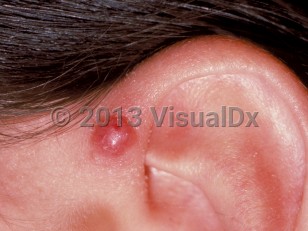Angiolymphoid hyperplasia with eosinophilia - Hair and Scalp
Alerts and Notices
Important News & Links
Synopsis

Angiolymphoid hyperplasia with eosinophilia (ALHE), also known as epithelioid hemangioma, is an uncommon, benign vascular proliferation typically seen in young to middle-aged adults. There is no sex predilection.
ALHE typically presents with skin-colored, pink, dull red, or brown papules or nodules on the head and neck. Approximately 50% of patients have multiple lesions that tend to be clustered particularly around the ears, forehead, and scalp. Other less common locations include the genitals (vulva or penis), trunk, and distal extremities. Most lesions are located dermally but ALHE can involve the subcutis and deeper soft tissues.
ALHE may also involve extracutaneous sites such as bone, colon, parotid gland, mouth, and orbit. Peripheral eosinophilia may be present in a subset of patients.
ALHE may present with pain, pruritus, or spontaneous bleeding, or it may be asymptomatic.
The underlying pathogenesis is unknown. There is no consensus as to whether the condition is reactive, possibly in response to trauma, or neoplastic.
Of note, ALHE and Kimura disease, once thought to be disease variants, are now recognized to be separate, distinct diseases with specific clinical and histologic features.
ALHE typically presents with skin-colored, pink, dull red, or brown papules or nodules on the head and neck. Approximately 50% of patients have multiple lesions that tend to be clustered particularly around the ears, forehead, and scalp. Other less common locations include the genitals (vulva or penis), trunk, and distal extremities. Most lesions are located dermally but ALHE can involve the subcutis and deeper soft tissues.
ALHE may also involve extracutaneous sites such as bone, colon, parotid gland, mouth, and orbit. Peripheral eosinophilia may be present in a subset of patients.
ALHE may present with pain, pruritus, or spontaneous bleeding, or it may be asymptomatic.
The underlying pathogenesis is unknown. There is no consensus as to whether the condition is reactive, possibly in response to trauma, or neoplastic.
Of note, ALHE and Kimura disease, once thought to be disease variants, are now recognized to be separate, distinct diseases with specific clinical and histologic features.
Codes
ICD10CM:
D18.01 – Hemangioma of skin and subcutaneous tissue
SNOMEDCT:
125574005 – Angiolymphoid hyperplasia with eosinophilia
D18.01 – Hemangioma of skin and subcutaneous tissue
SNOMEDCT:
125574005 – Angiolymphoid hyperplasia with eosinophilia
Look For
Subscription Required
Diagnostic Pearls
Subscription Required
Differential Diagnosis & Pitfalls

To perform a comparison, select diagnoses from the classic differential
Subscription Required
Best Tests
Subscription Required
Management Pearls
Subscription Required
Therapy
Subscription Required
References
Subscription Required
Last Reviewed:10/22/2017
Last Updated:09/30/2019
Last Updated:09/30/2019
Angiolymphoid hyperplasia with eosinophilia - Hair and Scalp

